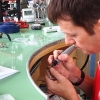Stereo Microscope
-
Recently Browsing
- No registered users viewing this page.
-
Topics
-
Posts
-
What's the movements so we know what size cases you're looking for and what are the setting requirements.
-
By LittleWatchShop · Posted
As I am getting close, I would like to know the total thickness of the bezel (top to bottom). I am working on two solutions--one is thinner than the other. The crystal sits pretty proud relative to the bezel, and seems consistent with the pictures I have seen. But, actual measurements would be nice. -
A little bit of superglue and you'll be good to go Although maybe if you had a laser welder you can weld the spring back together. Typically I've only seen it on blued steel Springs and on one occasion a modern spring? The modern watch was a Rolex watch that came and that was literally filled with rust including the barrel was filled with rust in the spring was in a whole bunch of little pieces. I have to wonder if that was an aftermarket mainspring . Then I'm attaching a PDF the Elgin watch company as you can see instigated a study in the 30s find out why mainsprings were breaking. I do though wonder if perhaps there may be a flaw in their study? One other things I wonder about is the metallurgy of the early steel Springs versus the later generation of blued steel Springs whether the metallurgy as part of the problem but in a case they did a study and have attaching a PDF. Because of the study any time I do anything with the blued steel spring when I actually cannot get something that's not blued. Once the spring is cleaned I'm very careful to not to touch the spring with my fingers because I don't want to have a problem with the chemicals on your fingers causing rust and I very carefully get lubrication back on the spring as fast as possible just to avoid these unpleasant situations. Then yes it is interesting one minute you of functional spring and the next minute you have lots of little pieces of spring. For my own personal Elgin pocket watch I put a steel spring and in this happened I'm also guessing that when one layer breaks it sends a cascading shockwave through the spring and that's why it breaks all the way across because after all there is a lot of energy in the spring when it breaks. Oh and my theory on the metallurgy is based on things have improved and for the most part I don't think I've seen a shattered spring in quite some time. Elgin_Mainsprings.PDF
-
Hi all A bit of an off chance one but has anyone got any links to suppliers of Conversion cases, to adapt pocket watch movements to wrist watches. I have a couple of movements and bring in the UK there is little chance of finding a replacement case so thought about converting them to wrist watches, I have seen loads of converted watches for sale so there must be a supplier somewhere, anyone know of a supplier. Thanks Paul
-
Thank you very much. I routinely harvest these strips so will be able to attempt a repair - much more interesting & potentially satisfying than acquiring a new replacement item.
-





Recommended Posts
Join the conversation
You can post now and register later. If you have an account, sign in now to post with your account.
Note: Your post will require moderator approval before it will be visible.